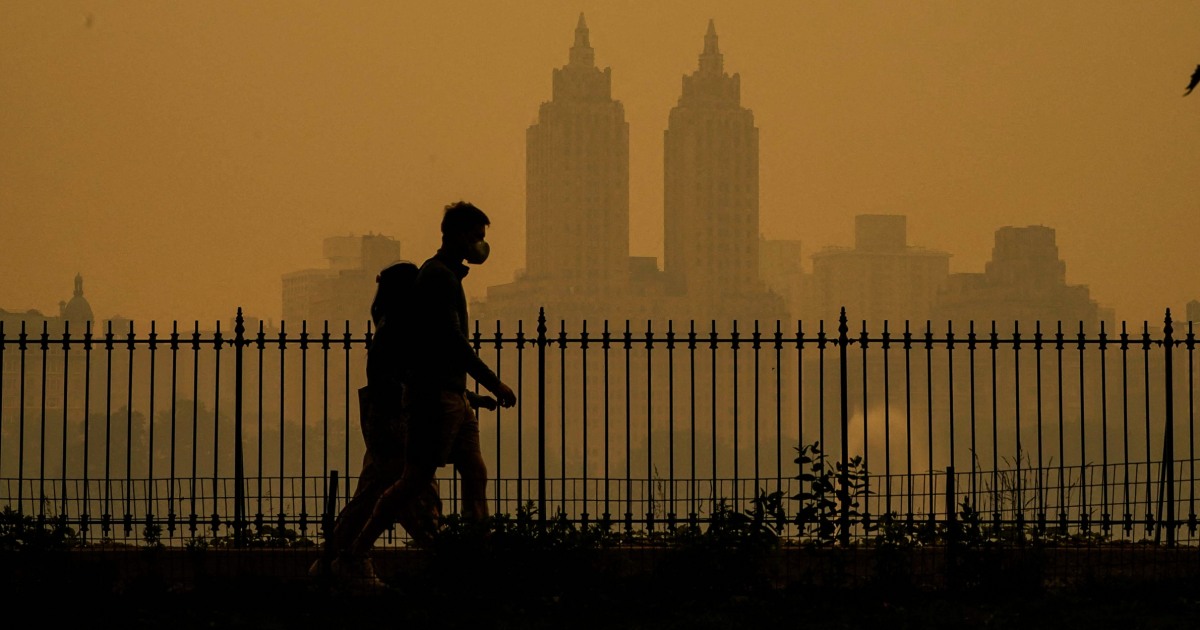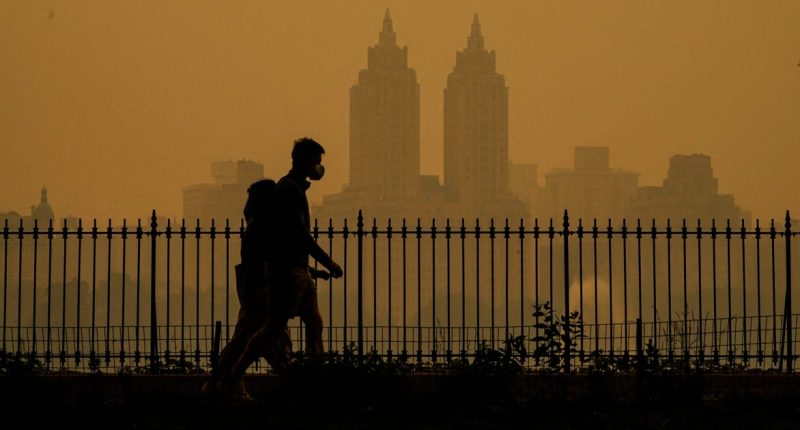
Nearly 40% of people in the U.S. are living in areas with unhealthy levels of air pollution and the country is backsliding on clean air progress as the effects of climate change intensify, according to a new report from the American Lung Association.
The organization’s report — its 25th annual analysis of the “State of the Air” in the country — found that between 2020 and 2022, 131 million people were living in areas with unhealthy levels of air pollution. The figure increased by nearly 12 million since the last survey a year ago.
The report also found that people in the United States experienced more “very unhealthy” or “hazardous” air quality days than any time in the survey’s history.
Katherine Pruitt, the national senior director for clean air policy at the American Lung Association, said climate change is chipping away at decades of cleanup efforts made through the Clean Air Act, a federal law passed in 1963 to regulate air pollution and set air quality standards.
“The changes happening in our climate and with heat and drought, and especially wildfire, have started to undo some of that progress we’ve made,” Pruitt said. “It is distressing to find that so many people are living with air quality that threatens their health.”
Wildfires are a fast-growing pollution source that policymakers are struggling to address. Climate scientists expect wildfire smoke to increase in the future, as greenhouse gas emissions push temperatures higher. The lung association’s analysis comes to the same conclusion as peer-reviewed research published last year in the journal Nature. Marshall Burke, an author of that study, suggested that wildfire smoke has undone about 25% of the Clean Air Act’s progress.
“If we take some steps back and tell what the root cause is, it’s the burning of fossil fuels,” said Dr. Lisa Patel, a clinical associate professor who practices as a pediatrician at Stanford Medicine Children’s Health. “We don’t need to be in this situation. We have the technology, we have the federal investment to get on renewables. What we need now is the political will.”
Every year, the “State of the Air” report analyzes air quality data of the three previous years. The analysis focuses on ozone exposure and on short-term and year-round exposures to particle pollution. The report issues grades for each measure and then summarizes how many areas pass or fail for each grade. Nearly 44 million people now live in areas that failed at all three criteria, according to the report.
Small particles are a significant concern because they can penetrate into people’s lungs, circulate in the bloodstream and affect other organs.
These particles, which are merely a fraction of the size of a human hair, have been shown to raise risk for asthma, lung cancer, chronic lung diseases, preterm birth and pregnancy loss.
Patel, who is also the executive director of the Medical Society Consortium on Climate and Health, said she has noticed an uptick in preterm births during periods of heavy wildfire events and has begun to counsel parents about how heat and smoke are a risk factor during pregnancy.
“When we have weeks of poor air quality, we see more pregnant individuals coming in and delivering before 37 weeks,” Patel said, adding that parents often question whether their actions could have contributed to an early birth. “When they ask about risks for premature birth, I do say climate change. Both heat and wildfires are a risk factor. They’re not in your control.”
Additionally, Patel said she has noticed that patients in her pediatric clinic often complain of nasal infections, eye irritation and asthmatic exacerbations, among other ailments, when wildfire smoke events happen in California.
Pruitt said particle pollution concerns once centered on the industrial Midwest and the Northeast. But in this report, for the first time, all 25 of the cities with the most daily particle pollution were in the West. Most were in California.
“Early in our history, a lot of particle pollution was coming from coal-fired power plants and transportation sources and industrial processes,” Pruitt said. “As the Clean Air Act has cleaned those sources up, particle pollution problems in the eastern U.S. have gotten much less serious. But in the West, they’ve of course had the same access to regulations and cleanups, but they are also being gobsmacked by climate change and wildfire.”
Daniel Mendoza, an assistant professor of atmospheric sciences at the University of Utah, said many communities in western states are dealing with acute, short-term pollution episodes rather than chronic exposures over a long period of time. Scientists are still trying to untangle how damaging wildfire episodes are in comparison to extended exposures from industrial sources.
“Not all bad air pollution is created equal,” Mendoza said.
Pollution from transportation and industrial sources could continue to decline if the Environmental Protection Agency is able to implement the more stringent standards it has proposed. The EPA proposed a rule last year that would require nearly all of the country’s coal and large gas plants to reduce or capture about 90% of their carbon dioxide emissions by 2038.
This March, the agency implemented stricter rules to reduce tailpipe emissions from passenger vehicles. Another EPA policy, aimed at curbing nitrogen oxide pollution that travels across states, was challenged in the U.S. Supreme Court. In 2022, the Supreme Court limited the administration’s ability to use the Clean Air Act to reduce greenhouse gas emissions.
The report has one bright spot: Ozone pollution has continued its dramatic improvement. About 2.4 million fewer people are living in areas with unhealthy ozone pollution in comparison to last year.
Wildfire smoke has worsened in the time since this analysis was complete: Americans in 2023 breathed in more wildfire smoke than any other year on record, the Stanford researchers found last year.
Source: | This article originally belongs to Nbcnews.com









